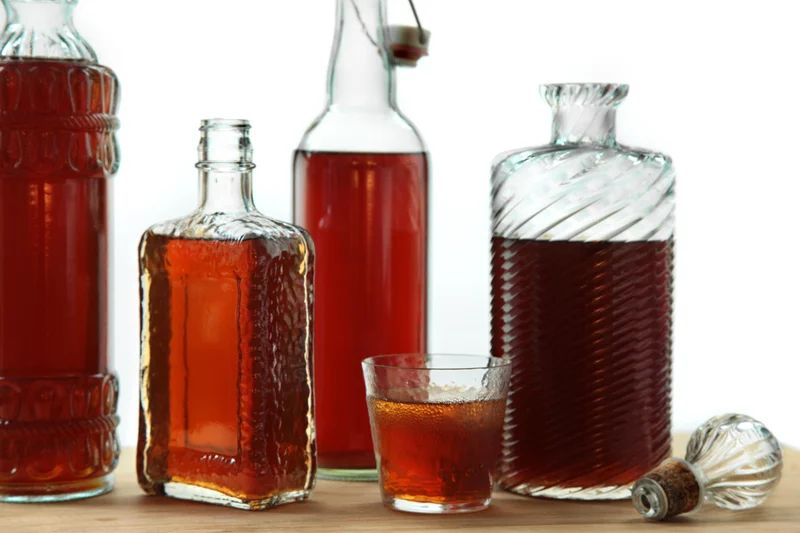The beauty of making your own amaretto lies in controlling the sugar content of this almond liqueur. In a side-by-side tasting of our homemade amaretto and popular commercial brands, ours was less sweet and had a true almond flavor. For the sweet tooths out there, just add more sugar.
What to buy: Apricot kernels are the dried seeds of fresh apricots. They have an almondlike yet bitter flavor and can be found online.
Bottled or purified water is important because any impurities in the water may affect the final flavor of the liqueur.
Special equipment: You’ll need a flat-bottomed, basket-style paper coffee filter. (The smaller, cone-style coffee filters are not big enough and tend to fall over during the filtering process.) Try bumming one from your local coffee shop or buy some online.
You will also need two large pieces of ultrafine woven cheesecloth. It can be purchased at cooking supply stores or online.
Game plan: After soaking the apricots and combining the macerating ingredients, there is a 4-week waiting period, so if you’re planning on giving your homemade amaretto as a gift, be sure to factor in the month of infusing time.
This recipe was featured as part of our DIY Holiday Gifts Advent Calendar.
- Yield: About 4 cups
- Difficulty: Easy
- Total: 20 mins, plus macerating, filtering, and infusing time
- Active: 20 mins
Ingredients (13)
For the macerating mixture:
- 1/2 cup coarsely chopped dried apricots
- 3/4 cup bottled or purified water
- 2 cups vodka
- 1 3/4 cups whole, skin-on, coarsely chopped almonds
- 1 cup brandy
- 1/4 cup coarsely chopped apricot kernels
- 1/4 cup coarsely chopped unsweetened, dried cherries
To finish the liqueur:
- 1/2 cup packed dark brown sugar
- 1/2 cup granulated sugar
- 1/2 cup bottled or purified water
- 1 cup vodka
- 2 teaspoons almond extract
- 1 teaspoon vanilla extract
Instructions
For the macerating mixture:
- In a 2-quart jar with a tightfitting lid, soak the apricots in the bottled or purified water until they’re rehydrated and most of the liquid has been absorbed, about 3 hours.
- Add the remaining ingredients to the jar, cover, and shake. Place in a cool, dark place to macerate for 4 weeks, shaking once per week.
- After 4 weeks, line a medium fine-mesh strainer with two 13-by-15-inch pieces of ultrafine cheesecloth and place over a large bowl. Drain the contents of the jar through the cheesecloth and into the bowl. Press on the solids, then gather the corners of the cheesecloth and squeeze the solids to extract as much liquid as possible. (Be careful not to let any solids drop into the strained liquid.) Discard the cheesecloth and solids; reserve the liquid.
- Rinse and dry the strainer and place it over a second large bowl. Set a flat-bottomed paper coffee filter inside the strainer and pour the reserved liquid into the filter. (Be careful not to spill into the bowl.) Let the liquid filter undisturbed until all of it has passed through and only a sludgelike beige film is left in the filter, about 5 hours. Remove the strainer, discarding the filter. Measure the liquid in the bowl—you should have about 1 3/4 to 2 cups. (The amount of liquid will determine how much sugar syrup you’ll add later.) Return the liquid to the bowl.
To finish the liqueur:
- While the macerating mixture is filtering, make the sugar syrup. Place both sugars and the bottled or purified water in a small saucepan set over medium heat, stirring until the sugars have dissolved, about 5 minutes. Remove from the heat and let cool to room temperature.
- Add the vodka, almond extract, and vanilla extract to the reserved filtered liquid and stir to combine. Add about half of the sugar syrup and taste the liqueur. Depending on how much filtered liquid you have and how sweet you like your amaretto, you may want to add more or all of the syrup. Stir to combine. Transfer to a 1-quart container with a tightfitting lid or small individual containers and store in a cool, dark place for up to 6 months.

